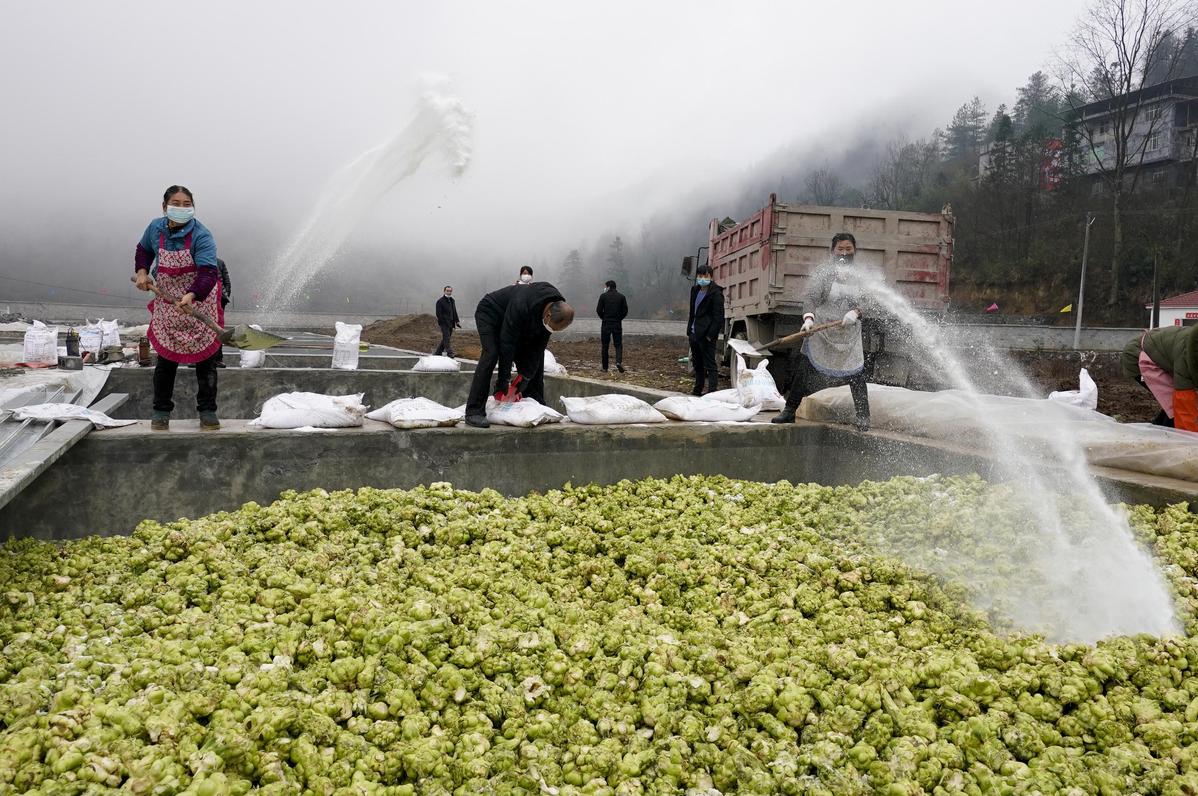Warning issued on traditional pickling


Two methods
In Sichuan province, pickled food is produced mainly by two methods. One is used to preserve it for longer, and the other, known as "bath-pickling", entails making it overnight.
Tang Aofei, 30, a chef from Leshan, Sichuan, who specializes in the province's cuisine, said that when he was a boy, he was always caught stealing pickles in the family kitchen.
"My favorite pickle is cowpeas," Tang said. "When I came home from school and dinner was not ready, I would pick some cowpeas to eat as a snack."
An earthenware jar stands in Tang's home, to which his mother keeps adding cowpeas and radishes. They are usually marinated for a week. Another earthenware jar is used to marinate ingredients such as ginger for a longer period to cook with fish or meat.
In the family kitchen, there are also glass jars to marinate the "bath pickle". "Bath pickle can be ready overnight, is crunchy and fresh, but not too salty or sour," Tang said.
He learned to make Sichuan pickles from his aunt. "The key is looking after the brine. It's like taking care of a potted plant that you have to watch every day. You also have to choose the right spot in which to place the jar," he said.
"If the brine becomes too sour, or there are too many flower-like bacteria in it, you need to restart," he said.
Tang added that if it is well looked after, brine can keep for more than 20 years.
He said that when his aunt and her husband went on long-distance trips, they always traveled with a jar of their pickle.
Popular choice
In Zhejiang, Anhui and Guangdong provinces, meigancai, a dry pickled Chinese mustard, is one of the most popular foods.
The green Chinese cabbage used to make the mustard is harvested and trimmed before Qingming Festival, before being placed in sun to dry.
It is salted or placed in brine, kneaded and left to ferment in large clay urns for 15 to 20 days. The cabbage is then repeatedly steamed and dried until it turns reddish brown and becomes highly fragrant. It is usually cooked with stews.
In Chongqing, the most popular pickled food is zhacai from Fuling district-a type of pickled green-stem Chinese mustard, which is salted, pressed and dried before being rubbed with chili paste. It is then fermented in an earthenware jar.
It is both crunchy and tender, and the taste is a combination of spicy, sour and salty.
In 2008, the craft of making Fuling zhacai, a popular product considered a good accompaniment for instant noodles, was inscribed as a national intangible cultural heritage.
Fuling Zhacai has become a popular local brand valued at more than 34 billion yuan ($5.07 billion). The company's income last year was nearly 2 billion yuan.
Even though pickles are mostly homemade, some time-honored brands largely use modern facilities to manufacture them. They usually start by mastering the skills required to make handmade pickles, before producing these uniquely-flavored products on a mass scale.
Sanhesimei, founded in 1817, is a well-known traditional pickle brand from Yangzhou, Jiangsu province. Its pickles, made from ingredients such as cucumbers, Chinese artichokes and lettuce, are refreshing, sweet, crisp and tender, and retain the original taste of the ingredients without any additives being used.
In Beijing, Liubiju, which has made pickles for nearly 500 years, is the oldest and best-known manufacturer of its kind in the Chinese capital.
Its products include sweet radish, sweet cucumber and sugar garlic pickles. Ingredients for Liubiju pickles are carefully chosen and a strict working practice is followed. For example, the soybeans chosen come from Majuqiao, Fengrun county, Hebei province, and Tongzhou district in Beijing, as they are particularly plump and oily.
To make sugar garlic pickles, garlic from Shandong province is harvested before the summer solstice. The manufacturing process involves eight steps, including peeling, marinating and placing the rolled garlic in jars. The pickle is generally ready to use by Mid-Autumn Festival.
The craft of making Liubiju pickle was inscribed as a national intangible cultural heritage in 2008.
Yang Yinxi, 63, who comes from Shanxi province, and has been making soybean sauce and pickles for more than 40 years, cuts a 50-kilogram kohlrabi each day into slices less than 2 millimeters thick.
In an interview with Beijing media outlet Qianlong, he said, "Compared with pickles made by using modern methods, the fermented soybean paste used for traditional handmade pickles ensures a rich flavor that modern skills cannot match."
Local artichokes are key ingredients for Chinese pickles, with those grown in Helan county, Ningxia Hui autonomous region, among the most-prized in the country.
Tan Yong, deputy general manager of Houshengji, a local snack and pickle brand, said 70 percent of Chinese artichokes are grown in the county.
The artichokes are seeded in March and harvested in late September or October. This year, Houshengji used more than 7,000 metric tons of them to make pickles.
"The hardest job is digging them out of the soil. Unlike peanuts, which can be dug out with force, it is easy to break the skin of an artichoke. Once broken, it will soon go bad," Tan said.
After being harvested, the artichokes are washed, and those selected are marinated in large pools, where seasoning is added.


















